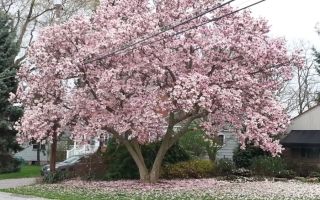Content
- 1 What it looks like and where it grows
- 2 Magnolia composition
- 3 Benefits of magnolia
- 4 Preparation and application methods
- 5 Application in traditional medicine
- 6 Application in cosmetology
- 7 Why is magnolia dangerous and contraindications for use
- 8 Collection and procurement
- 9 The magical properties of magnolia
- 10 Conclusion
The use of magnolia is in demand in folk medicine and in cosmetology. The plant has a beneficial effect on the cardiovascular system and helps with inflammation, and also allows you to stay young for longer.
What it looks like and where it grows
Magnolia (Magnolia) - a plant from the Magnoliaceae family, numbering more than 200 species. It is an evergreen or deciduous tree or shrub with brown or ash gray bark. The leaves are large, elliptical or obovate, with a solid edge, the flowers are single and rather large, up to 15 cm in diameter. In shade, buds with 6-12 petals can be red, white, lilac or pink, depending on the type of plant.
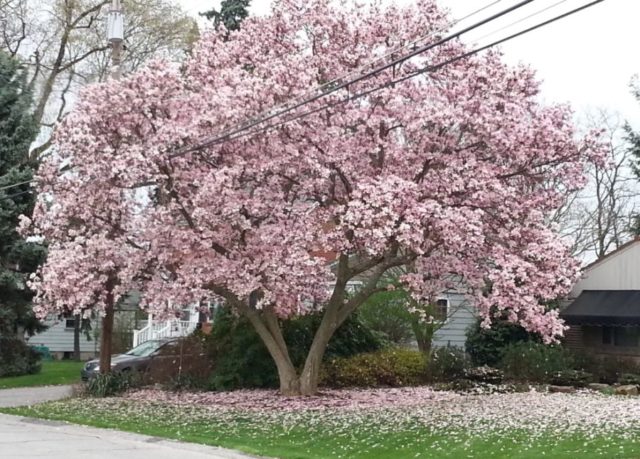
During the flowering period, which lasts from early March to June for different varieties, magnolia gives off a pleasant aroma. The fruits of the plant are prefabricated cone-shaped leaflets with wedge-shaped black seeds.
You can meet culture in North America, Japan, Korea and China. In Russia, it grows on the Kuril Islands and in the Caucasus near the Black Sea. Magnolia can be seen in city gardens and parks and is often used for landscaping.
Magnolia composition
The medicinal properties and contraindications of magnolia are due to the composition of its leaves, bark and flowers. The plant contains:
- essential oils;
- glycosides;
- oleic, stearic and linolenic acids;
- phenols;
- citral and cineole;
- rutin;
- vitamin C;
- fixed oils;
- sesquiterpenes;
- magnoflorin;
- peanut and myristic acid;
- alkaloids;
- selenium;
- tannins.
Magnolia requires careful use, since some of the components in its composition are toxic. But in small dosages, it has a beneficial effect on the body.
Benefits of magnolia
When used correctly, magnolia-based products improve health and help fight the symptoms of ailments. In particular, the plant:
- lowers blood pressure and increases vascular elasticity;
- has a diaphoretic effect for colds and relieves fever;
- tones up and energizes;
- accelerates skin healing in case of damage and inflammation;
- disinfects wounds and cuts;
- improves the functioning of the heart system;
- increases the body's immune resistance;
- promotes the elimination of edema;
- cleanses the body of toxins and toxins.
The plant is used in the treatment of rheumatism and arthritis.

What are the benefits of fruits
Traditional medicine uses not only the leaves of the plant, but also the fruits. They contain a large amount of acids and flavonoids.The fruits are used for diseases of the digestive system, with slow metabolism, for healing mucous membranes and relieving spasms. They are also used in the preparation of anti-inflammatory drugs for joint ailments.
Benefits of Magnolia Bark
The bark of the plant contains many tannins. Decoctions and infusions based on it are used for gastritis and colitis, with increased pressure, with fever and chills during the flu and SARS. The bark is used to stimulate contractions in women with weak labor, chronic fatigue and reduced immunity.
Decoctions are used in myocardial diseases, since they relieve heart pain and slow down the pulse rate. But in such cases, you can use them only with the permission of a doctor.
Magnolia scent properties
The flowers of the plant contain a huge amount of essential oils and give off a pleasant sweet scent. With moderate inhalation, the smell normalizes blood pressure and relieves headaches, promotes vasodilation and accelerates blood flow. The aroma has aphrodisiac properties and enhances libido, calms the nervous system and eliminates irritability.
At the same time, it is not recommended to put a flowering plant in the bedroom or near the desk. If inhaled for a long time, the aroma has the opposite effect - it provokes migraines, dizziness, irritability and fatigue.
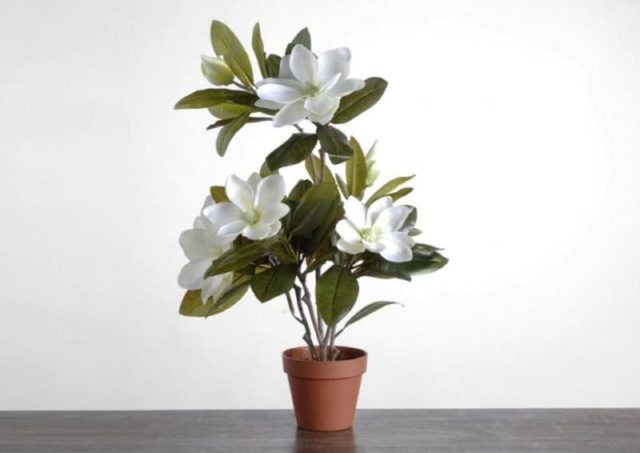
Magnolia extract properties
The plant extract is available in pharmacies. It is produced from dry concentrate of bark, seeds or leaves. The remedy has a very rich composition and is beneficial for hypertension, weakened blood vessels and malfunctions of the heart system.
Magnolia extract contains many alkaloids and essential oils. You need to use the tool strictly according to the instructions so as not to face an overdose. When used carefully, the extract strengthens the immune system and protects against the development of chronic ailments.
Magnolia essential oil properties
The essential oil obtained by steam distillation from the leaves and flowers of the plant is valued primarily in cosmetology. It is found in fine perfumes, creams, shampoos and shower gels.
Traditional medicine recommends adding the plant oil to water for inhalation when fighting coughs and colds. Ether is used for rubbing joints with rheumatism, and is added to healing baths for skin diseases. Regularly rubbing the epidermis with magnolia oil helps to get rid of acne and acne.
Preparation and application methods
Traditional medicine uses all parts of the medicinal magnolia, its leaves, flowers, fruits and wood. Usually, the raw materials are insisted on an alcohol or water base, while valuable substances pass into a liquid.
Magnolia tincture
Strong tincture of magnolia is used for colds, sluggish digestion, infections and joint ailments. It is prepared according to the following algorithm:
- Magnolia seeds are ground in a volume of 10 g.
- The raw material is poured with a glass of 70% medical alcohol in a glass container.
- Shake thoroughly and remove for 10 days in a dark place.
After the expiration of the period, the tincture is filtered and taken 30 drops before meals three times a day. In total, the treatment can be continued up to a month, then they must take a break.
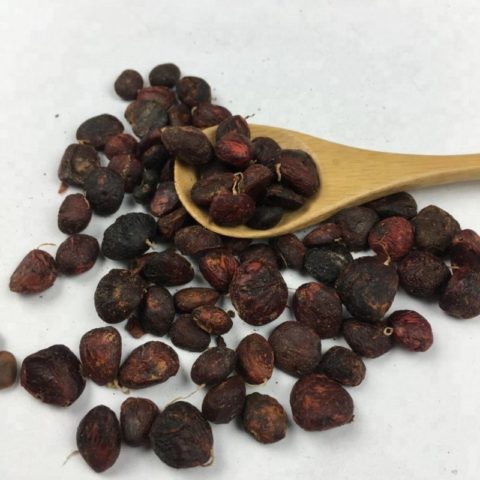
Infusion
The water infusion of the plant is in demand mainly in hair care. They do it like this:
- Grind two large tablespoons of dry leaves.
- Pour the raw material of the plant with 1 liter of hot water.
- Leave for a day under a closed lid.
- Strain through cheesecloth.
The infusion of the plant is used for rinsing with dandruff, itching and profuse early baldness.You need to use it once a week for several months.
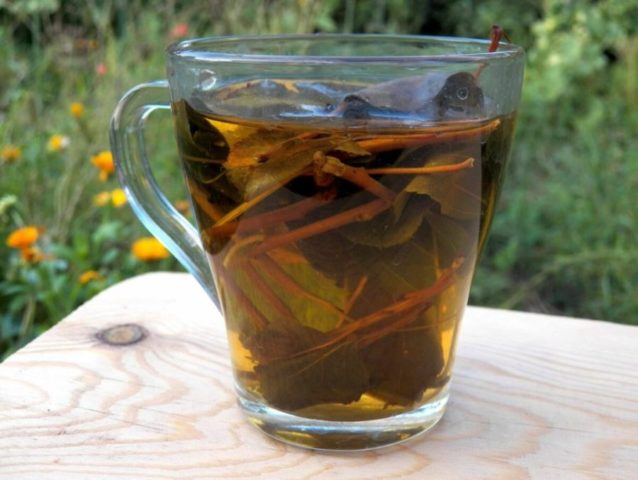
Application in traditional medicine
For the treatment of ailments, traditional medicine uses mainly plant tinctures. They have the strongest healing effect and quickly relieve unpleasant symptoms.
With heart disease
With sluggish work of the cardiac system, it is useful to use the following tincture:
- The bark, seeds and flowers of the magnolia are crushed and mixed.
- Measure 10 g of raw materials and pour 250 ml of medical alcohol.
- For 20 days, remove the container for infusion in a warm and dark place.
- After reaching readiness, filter.
You need to take the drug up to four times a day, 15 drops. Previously, the agent is diluted in a small amount of water so that alcohol does not burn the mucous membranes. The tincture has a tonic effect and accelerates blood circulation, normalizes heart rate and improves overall well-being.
With rheumatism
The anti-inflammatory properties of magnolia have a beneficial effect on the body against rheumatic pains, arthritis and gout. For internal use, prepare the following tincture:
- Grind two small spoons of plant seeds.
- Pour raw materials in a glass vessel with a glass of 70% alcohol.
- Shake the container and put it in a darkened cabinet for ten days.
- After a lapse of time, filter from the precipitate through cheesecloth.
You need to take the tincture 30 drops on an empty stomach or after meals three times a day. At the same time, you can use a remedy for rubbing sore joints. The tincture has good warming properties and helps relieve local swelling.
With hypertension
Tincture of medicinal magnolia leaves lowers blood pressure and improves vascular health. A medicinal preparation is prepared according to this recipe:
- Dried leaves are crushed in a volume of 10 g and filled with 100 ml of medical alcohol.
- They are removed for infusion for two weeks in a dark cool place.
- From time to time, remove the vessel to shake.
- Over time, filter from the remnants of the leaves.
Tincture of the plant should be drunk at the same time with food intake, 20-30 drops up to three times a day.
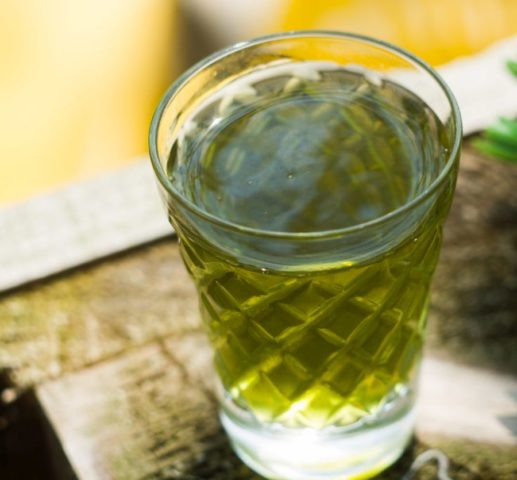
With a fever
The benefits and harms of magnolia bark are in demand at high temperatures for flu and colds. Tincture based on the wood of the plant relieves heat, removes toxins from the body and helps to improve overall health. Prepare the drug for home use as follows:
- Grind two small spoons of dried bark.
- Pour wood raw materials with a glass of alcohol or high-quality vodka.
- Insist in a dark place with a low temperature for two weeks.
- Filter through cheesecloth.
Tincture of magnolia bark is drunk 25 drops three times a day between meals.
When coughing
Healing magnolia extract promotes expectoration when coughing, eliminates bacterial processes in the bronchi and helps to quickly get rid of sore throat. A plant-based agent is usually used as part of inhalations:
- In a small saucepan, bring 1 liter of water to a boil.
- Allow the liquid to cool slightly.
- Add 3-5 drops of magnolia extract to the water.
- Lean over the container and carefully inhale the rising steam.
When inhaling, you need to breathe slowly and shallowly. The main purpose of the procedure is to warm up the airways, but the effect of the steam should not be scalding.
Application in cosmetology
Magnolia can be found in a wide variety of cosmetics. Plant extracts are added to masks and lotions, serums and creams, conditioners and hair balms, massage mixtures.
In the field of beauty, not only the beneficial properties of magnolia are appreciated, but also its pleasant aroma.The plant extract is in demand in the production of perfumery products - perfumes, eau de toilette, deodorants.
At home, decoctions and infusions can be used to take care of the skin and hair. They are used:
- with rosacea and fading skin;
- with dry and sensitive epidermis, prone to allergic rashes;
- with fungal diseases;
- with weakened hair falling out;
- with dandruff and itching of the scalp;
- with dark circles under the eyes.
Tincture of the plant can be used to treat acne and irritation on the skin. Magnolia will help disinfect inflammation, accelerate the resorption of abscesses and normalize the fat content of the epidermis.
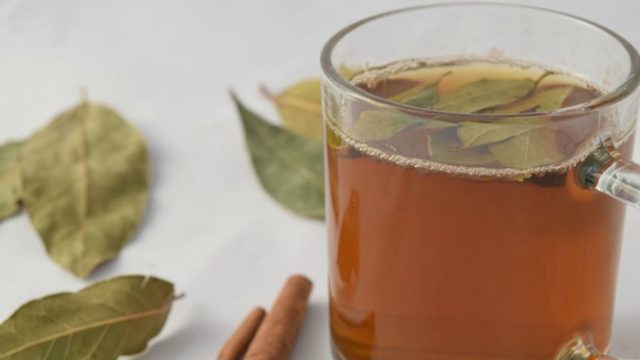
Why is magnolia dangerous and contraindications for use
The use of magnolia fruits, plant leaves and bark is not allowed for everyone. It is necessary to refuse the use of natural infusions and decoctions:
- with individual allergies;
- during pregnancy in the first trimester;
- during breastfeeding;
- in children under three years of age.
Magnolia belongs to the category of slightly toxic plants and is dangerous in case of overdose. If you exceed the safe amounts of medicines or inhale the aroma for too long, side effects may come to light - nausea, dizziness, fatigue, headache. If you feel worse, you should immediately stop using Magnolia and consult a doctor.
Collection and procurement
For medicinal use, magnolia leaves, bark and flowers are harvested in early spring, during the decorative period of the plant. Fruits and seeds are harvested closer to autumn after ripening.
The collected raw materials of the plant are laid out in a thin even layer in the air in the shade or in a warm ventilated room. After the moisture has completely evaporated, the workpieces are poured into paper or fabric bags and placed in a dark cabinet.

The magical properties of magnolia
There are many signs and superstitions associated with beautiful and useful magnolia. It is believed that the plant attracts love and family happiness, for girls it brings the proposal of marriage closer. In the language of flowers, magnolia symbolizes perseverance, if a young man gives such a bouquet to his chosen one, this indicates his serious intentions.
According to legends, the plant strengthens mental strength and gives determination, promotes peace and tranquility. In a house where magnolia grows, quarrels and scandals rarely occur. Aromatic essential oil in mystical practices is used for meditation.
Conclusion
The use of magnolia is practiced in folk medicine and cosmetology. The beneficial plant helps to maintain freshness and youthfulness of the skin, strengthens the hair and gives it shine. Magnolia extracts and tinctures help to cure colds and cardiovascular diseases.

